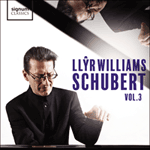
Welcome to Hyperion Records, an independent British classical label devoted to presenting high-quality recordings of music of all styles and from all periods from the twelfth century to the twenty-first.
Hyperion offers both CDs, and downloads in a number of formats. The site is also available in several languages.
Please use the dropdown buttons to set your preferred options, or use the checkbox to accept the defaults.

| Llŷr Williams (piano)» More |
The sonata is in four movements, and has been noted for its Alpine qualities, both in melody and rhythm. The first, Allegro vivace, opens with a fanfare, immediately repeated in the minor, later developed in characteristic Schubertian manner in an exposition that wanders through many remote keys. The second subject has been compared to the sound of Austrian yodelling, and has some similarity with Schubert’s setting of Pyrker’s Das Heimweh. The second movement is in A major, and is in ABABA form, with a faster tempo than is usual in Schubert’s second movements of piano sonatas. The triplet figure that is so marked in the first movement reappears here. The second subject has some violent syncopation, which then merges with the more meditative opening subject as the movement comes to its conclusion. The third movement is a scherzo and trio in G major, with a lively, dotted quality to the scherzo and a steady lyricism to the trio. The last movement, again in D major, is a rondo in ABACA form, the main theme being a military march, repeated with variations and divisions, and interspersed with contrasting episodes, leading to a quiet coda.
from notes by Simon Rees © 2019
 Schubert: A Schubert Journey Schubert: A Schubert JourneyWelsh pianist Llŷr Williams is widely admired for his profound musical intelligence and the expressive and communicative nature of his interpretations. These recordings were made in conjunction with a critically lauded recital series at the Royal ...» More |
 Schubert: Piano Music, Vol. 3 Schubert: Piano Music, Vol. 3Two imposing piano sonatas—the upbeat D850 from 1825 and D958 composed in 1828 and very much a homage to Beethoven at whose funeral the previous year Schubert had been a pall-bearer—recorded during Llŷr Williams' Cardiff series in 2017/18.» More |

